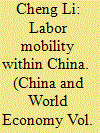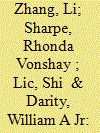| Srl | Item |
| 1 |
ID:
094662


|
|
|
|
|
| Publication |
2010.
|
| Summary/Abstract |
Labor migration is institutionally restricted within China under the hukou system, China's registration system. However, what is the pecuniary impact of labor immobility on interregional wage inequality? To answer this question, we derive a simple wage gap equation including educational attainment, market potential and provincial border indicators. The regressions based on city and sector-level data show that, other things being equal, the wage dispersions within Chinese provincial borders are significantly less pronounced than those among provinces. Such border effects on spatial wage differentials, which have been shown to pervasively exist in all sectors considered in the present paper, reflect the distortions generated by migration controls. Finally, we show that despite the recent hukou reforms aimed at relaxing the restrictions on population movement, border effects appear to persisted over the period 2003-2005
|
|
|
|
|
|
|
|
|
|
|
|
|
|
|
|
| 2 |
ID:
149771


|
|
|
|
|
| Summary/Abstract |
Since the end of the 1980s, the number of migrants working in the urban labor market has increased dramatically. However, migrant workers are treated differently from urban workers. In this paper we examine the labor market discrimination against rural migrants from the point of view of wage differentials using CHIP-2007 data. We apply Jann pooled method to deal with index number problem and use Heckman two step model to correct selection problem when decomposing the wage gap. The decomposition results show that a significant difference in wage gains persists between the two groups as late as 2007. In 2007 migrants only earned 49% of urban workers' income and 17% of the wage gap cannot be explained by observed factors. In detail, differences in educational attainment, work experience and distribution across industry, occupation, and ownership of enterprises account for most of the explained wage gap.
|
|
|
|
|
|
|
|
|
|
|
|
|
|
|
|